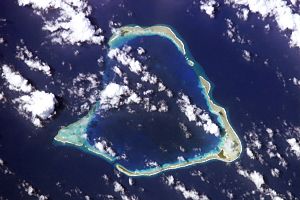Rongdrik
| Rongdrik | ||
|---|---|---|
| NASA image by Rongdrik | ||
| Waters | Pacific Ocean | |
| archipelago | Marshall Islands | |
| Geographical location | 11 ° 20 ′ N , 167 ° 27 ′ E | |
|
|
||
| Number of islands | 17th | |
| Main island | Jitoen | |
| Land area | 4.4 km² | |
| Lagoon area | 373 km² | |
| Residents | uninhabited | |
Rongdrik or Rongerik (German outdated: Pescadores Islands ) is an atoll of the Ralik chain of the Marshall Islands . The atoll has a land area of 4.4 km², which encloses a lagoon of 373 km². The atoll is 200 km from Bikini Atoll .
The Rongdrik Atoll gained notoriety through the settlement of the former inhabitants of the Bikini Atoll. They had to leave their homes in the spring of 1946 so that the US government could conduct Operation Crossroads , their second series of nuclear tests, there in July 1946 . However, the Rongdrik Atoll offered neither sufficient food supplies nor sufficient drinking water. The bikinians who had been brought to the atoll with supplies for a few weeks began to slowly starve to death. By July 1947 at the latest, American officials were also aware of the impending famine. In November 1947, an advance group of bikinians began to develop the Ujelang Atoll as a future home. Shortly thereafter, however, the US government decided to use the Eniwetok Atoll as another nuclear test area. Since Eniwetok was also settled, another new home was now missing. The US government found the Ujelang atoll to be the best place to do this and relocated Eniwetok residents there, making it impossible for bikinians to settle there.
After another stopover on the Kwajalein Atoll , the bikinians found a home on Kili from November 1948 . As an island, Kili - unlike an atoll - has no lagoon. As a result, the bikinians on Kili could not resume their previous way of life, which was characterized by lagoon fishing, and were dependent on external aid supplies for their survival. These came mostly by ship, which was made more difficult by the fact that Kili had no significant landing possibilities and is usually surrounded by high breakers. Some relief supplies were therefore thrown from the air. In order to increase the possibilities for self-sufficiency, the residents were given rights to the neighboring atoll Jaluit in 1957 , which was made uninhabitable in 1958 by typhoon Ophelia - after typhoon Lola in Kili had destroyed large parts of the harvest in 1957 and sunk the supply ship.
In 1954, 26 soldiers were stationed on the deserted Rongdrik to document the effects of the Bravo bomb detonated on Bikini . The cloud with the radioactive fallout reached Rongdrik after eight hours and irradiated the soldiers stationed at the weather station. They were brought to a military base on Kwajalein Atoll for observation , but were released as healthy after six months at the latest.
The US government (President Johnson) finally promised the bikinians that they would return to the atoll soon in 1968 and began removing radioactive debris and planting coconut trees. In 1972 three large families first moved back to Bikini. From 1975, however, it slowly became apparent that the Bikini Atoll was by no means to be inhabited. After studies had shown that both the drinking water and the main food source (coconuts) still had increased levels of radiation, all inhabitants left the atoll in 1978.
Until today (2010) the Atoll Bikini cannot be settled because of the radiation. Since 1975, the bikinians have been fighting in court hearings before the United States Supreme Court for adequate compensation and the decontamination of the atoll.
The atoll Rongdrik itself was finally radioactively contaminated in early 1954, as were the neighboring atolls Rongelap , Utirik , Ujelang , Likiep , Bikar and Ailinginac through Operation Castle and subsequent atomic bomb tests and is still not habitable to this day.
Web links
- Image and short description (Engl.) ( Memento of 23 December 2010 at the Internet Archive )
- Legend of the Murdered Flower Girls
- History of the Bikini Atoll
Individual evidence
- ↑ German Colonial Lexicon. Edited by Heinrich Schnee. - Leipzig: Quelle & Meyer 1920. - 3 vols.
- ↑ Steven L. Simon, André Bouville and Charles E. Land, Fallout from Nuclear Weapons Tests and Cancer Risks: Exposures 50 years ago still have health implications today that will continue into the future. American Scientist 94/1, 2006, 52
- ^ Radioactive Fallout in the Marshall Islands. Science, New Series 122 (No. 3181, Dec. 16), 1955, 1178
- ↑ Jonathan Weisgall: Operation Crossroads: The Atomic Tests at Bikini Atoll . Pp. 314-315
- ↑ bikiniatoll.com: US Reparations for Damages ; As of April 4, 2010


